My favorite parts of any aircraft build are painting the interior, painting the exterior, and weathering the model. If anything is the “doldrums” in a build, it has to be assembly. So anytime a model allows that part of the process to move along without much fanfare, I am quite happy with it.
And I was quite happy with Trumpeter’s L-39ZA.
Not that there weren’t a few areas that needed addressing, but they were easy enough to deal with.
Before closing up the fuselage, the engine exhaust assembly, cockpit unit, and nose wheel bay must be glued into one fuselage half. However, I wanted to make sure all fit well.
From Facebook
On my Facebook page, I often post in-progress shots, and discuss with followers of the page how things are going. Here are some questions from Facebook:
Kevin asked “How did the intake assembly go?“
The intakes are actually a single piece, so there are no seams at all. They do have a solid “back wall”, so if you want to peer down them, you’ll not see anything. As I’m not to concerned about folks holding the model alongside their cheek to peer into them, I was quite happy as they were OOB.
Mark asked “Do you like that Stynelrez?“
Very much so, though I admit it has had to grow on me. When I initially tried it, I had quite a problem with later paint layers lifting with masking. Yet so many people reported good results with it, I decided to give it a few more tries. I found that by allowing more drying time – typically 24 hours, and by de-tacking my tape used for masking, I had no more problems.
I apply it through my Badger Patriot, with either a 0.5 or 0.7 nozzle, straight out of the bottle. My first coat is a light mist, and then I apply it much heavier. Not quite a full wet coat, but I don’t hold back too much.
Thanks for those questions, guys!
If you’ve not already “liked” my Facebook page, I’d be honored if you’d do so. Thanks!
I’ve found an easy way to identify where problems may occur. First, I dry fit the fuselage without any internal assemblies, and look for places that might not fit well. On most models, the typical suspects to look for are subtle ejector pin marks along the mating surfaces, slight flash “crowns” around the female side of alignment pins, and any sprue connection points that were not sanded down well.
My favorite tool in addressing each of those is a finer grade metal file. I don’t use one that is too aggressive in terms of grit because it will wear plastic down to fast. But a very light grit file works perfectly. I apply almost no pressure, and align it so it touches at least two of the mating surfaces, which gives a good, flat sanding angle. I work my way along the mating edges, dry fitting as needed, until I get a good fit.
Once the two halves are sorted out, I then begin fitting the internals one component at a time. This helps quickly identify if one of the internal components causes an issue. Because I know the fuselage fits without problem by itself, I can quickly identify where to make adjustments internally. Typically these areas will be along the sides of a fuselage assembly or gear bays. This can be addressed either with sanding of the assembly itself, or making room inside the fuselage.
In the case of this Albatros, apart from a few bits of sprue connection and very minor alignment pin flash along the fuselage mating surfaces, everything fit very well.
Before gluing it all together, I added nose weight to make sure I didn’t end up with a model that had “tail sit”. I tested this by taping the fuselage closed with all internals in place, adding the wings and tailplanes (dry fitted, of course). I then used a bit of poster putty to tack a small plastic measuring cup onto the nose of the model. This allowed me to add in bits of weight (I use lead shot) until I had enough to tilt the nose down. A key point to note is that I tested the “pivot point” slightly forward of where the main gear struts are to be mounted. This made sure that I was adding enough weight to account for a center of gravity far enough forward that the model won’t tip back easily.
I glued the lead shot into one fuselage half with super glue, working it around the internal components. Test fitting at this point is essential to ensure you don’t introduce fit issues. Once all of the weight was in place, I sealed it in with a bit of poster putty. This makes sure that if the glue fails, or a bit of lead breaks loose, it doesn’t rattle around inside the model.
With all of that sorted out, I closed up the fuselage, and applied Tamiya Extra Thin Cement along the seams, making sure to give them a good squeeze to create a strong bond. I used a few rubber bands to pull things together. This was set aside to dry.
I had already assembled the wings, though I did need to add the flaps and ailerons. The kit provides options for flaps up and down, my choice being up. These parts were added, and while they fit reasonably well, there was a slight bit of a gap between them and the wing. However, I knew I could address those at a later stage. The ailerons were also fitted without problem.
After the fuselage was sufficiently dry, I was ready to start sanding along the seam lines. Before I did this, a scribing tool was used to deepen the panel lines where in the areas to be sanded. This makes sure only minimal rescribing will be needed later, if any.
I prefer to start with a less course grade of sanding medium, in this case a 320 grit sanding stick. This avoids horribly gouging up the join area. I’ve seen so many modelers just attack the seams with a very aggressive grit – 180 or even 100 – and simply flat spot a model. Heck, I’ve done it in the past, and learned the hard way! However, if careful preparation is done before this stage, most seam lines will need only the lightest sanding, and any that need more will be exposed easily.
The two areas that needed a bit more work was the seam just aft of the cockpit “hump”, and along the upper nose from the cockpit forward. As I wanted to make sure I did not end up with ‘ghost seams” that often accompany traditional modeling putty, I applied a few beads of super glue thick, and used super glue accelerator to quickly cure it. I was then able to sand those areas – again using the least aggressive grit needed to do the job -, and quickly had that sorted out.
I used the “thumbnail” test to check everything. I do this by lightly dragging the tip of my thumbnail across the joins. Even the slightest imperfection will register, and alert you to where more application may be needed. Happily, all worked well.
With the fuselage ready, I added the wings, which were a near perfect fit, and the tailplanes, also near perfect. All that remained before I could prime was to address the minor hairline cracks along the various joins that were engineered along actual panel lines.
For these, I whipped out my trusty bottle of Mr. Surfacer 500, and “painted” a heavy bead along all join lines – flaps, ailerons, wing to fuselage join, and the tailplanes. I made sure the application was heavy enough to fill the areas, but not so much to leave gobs of leftovers to be sanded away.
I do this because… I don’t sand it away. 🙂
The next step is to grab a load of cotton buds, and some isopropyl alcohol. After allowing the Mr. Surfacer to dry to the touch (about 20 minutes) I then dipped a cotton bud in my alcohol, and started rubbing along the panel lines. While it takes a bit of work, this process removes the Mr. Surfacer from the… err… surface, but leaves it in the gaps. You may see there is quite a bit of “smear” marks left over, but these can be cleaned easily with a paper towel moistened with alcohol.
The final result was panel line joins that looked to be no more than actual organic panel lines. It’s a very useful and simple technique.
A final step was adding the forward windscreen, which fit well. The canopy parts do have a seam down the middle, but some gentle wet sanding with progressively lighter grades of sanding stick, followed by a good polishing, will take care of that. You can use proper polishing compound, but I simply used toothpaste. This has the extra benefit of leaving the canopy minty fresh, which is approved by 4 out of 5 dentists who build models. (The 5th one is very grumpy and is waiting in line for his nachos at the IPMS-US convention hall.)
I wanted to temporarily tack the remaining opening canopy parts in place using Future floor polish. This would effectively mask off the cockpit, and ensure the camo pattern extended across the canopy parts correctly. The rear section fit nicely, but the forward section did not align well. As my plan was to build this with both posed open, I simply added some paper towel masking. If you plan to fit yours closed, and you have the same issue, I recommend careful sanding along the aft edge of the forward windscreen (prior to affixing it to the fuselage) and to the forward edge of the pilot’s canopy, test fitting all along to make sure you only remove enough material to ensure a good fit.
Also, one note of accuracy is needed. Most of the time when you see an L-39 on the ground, it is flaps up, with all gear doors and brakes closed. The kit instructions show everything down. You can find a few reference photos that show this, but I preferred the “clean” look seen on most aircraft. A bit of sanding and test fitting will be needed to get a clean fit of the various kit parts in closed position. A small tab will need to be removed from the nose gear strut to allow later insertion of the part. Finally, the Albatros has small spring-loaded doors that pop into place where the main gear strut covers normally sit. I replicated this by using the strut gear doors as a template, cutting out copies with thin plastic sheet. I then glued them in place, and lightly scribed a panel line down the middle. See the close up underside photo below, and you may find this link to an image of the area useful too.
With all of that in pace, I gave the whole model a coat of Badger’s Stynylrez Gray Primer. This did highlight a few areas that needed further attention, so those will be sorted out and reprimed prior to painting. (Right now I’m allowing it a few days to dry and cure. And to work on other stuff… ;))
All in all, this little kit gave me no headaches – I sailed through the “doldrums” without much of a notice at all. As I’ve said before, say what you will about their accuracy, but Trumpeter (and Hobbyboss) do provide a pleasant, enjoyable building experience.
The next step will be the paint!
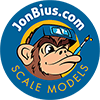
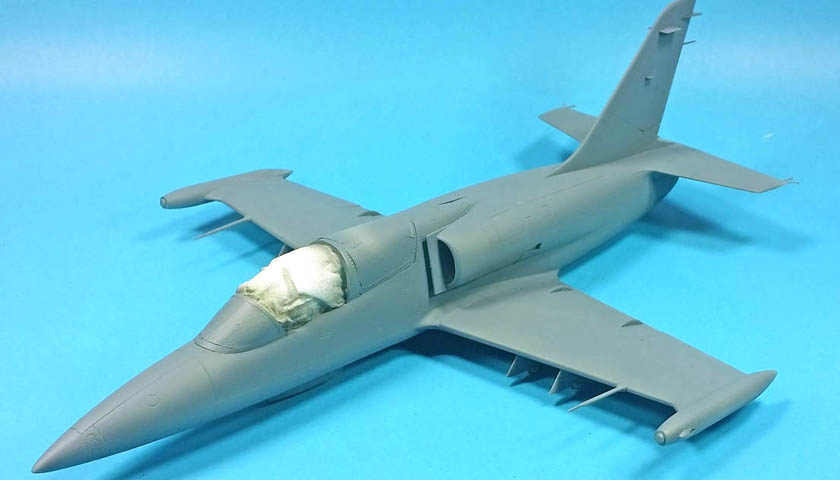



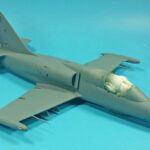
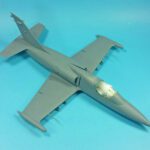

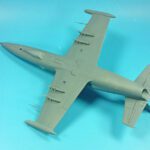


Leave a Reply